2011 Hyundai H-1 (Grand Starex) Engine
[x] Cancel search: EnginePage 327 of 338
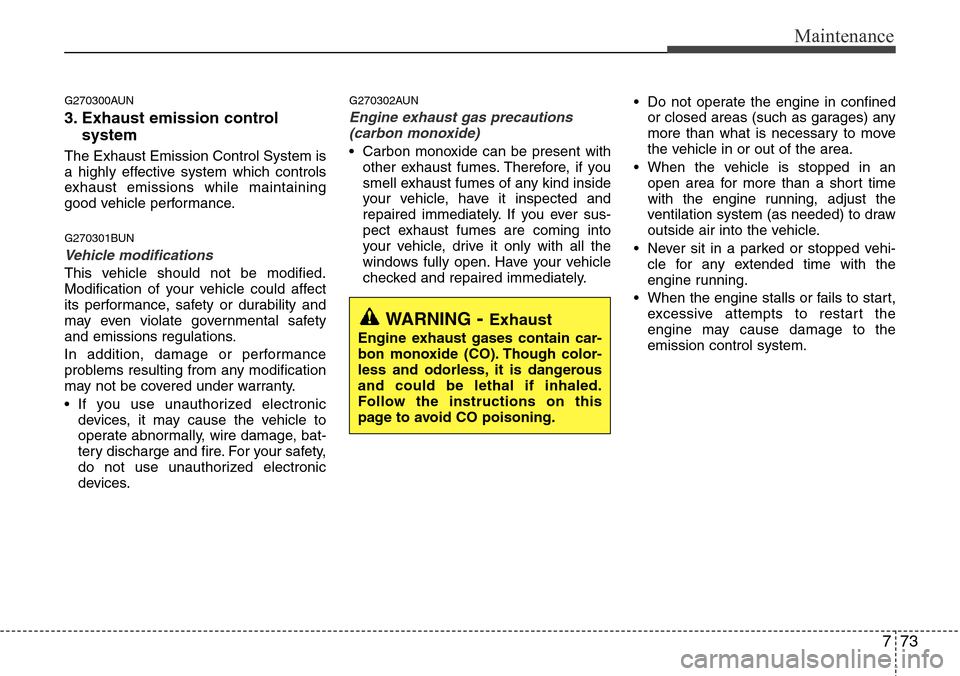
773
Maintenance
G270300AUN
3. Exhaust emission control
system
The Exhaust Emission Control System is
a highly effective system which controls
exhaust emissions while maintaining
good vehicle performance.
G270301BUN
Vehicle modifications
This vehicle should not be modified.
Modification of your vehicle could affect
its performance, safety or durability and
may even violate governmental safety
and emissions regulations.
In addition, damage or performance
problems resulting from any modification
may not be covered under warranty.
• If you use unauthorized electronic
devices, it may cause the vehicle to
operate abnormally, wire damage, bat-
tery discharge and fire. For your safety,
do not use unauthorized electronic
devices.
G270302AUN
Engine exhaust gas precautions
(carbon monoxide)
• Carbon monoxide can be present with
other exhaust fumes. Therefore, if you
smell exhaust fumes of any kind inside
your vehicle, have it inspected and
repaired immediately. If you ever sus-
pect exhaust fumes are coming into
your vehicle, drive it only with all the
windows fully open. Have your vehicle
checked and repaired immediately.• Do not operate the engine in confined
or closed areas (such as garages) any
more than what is necessary to move
the vehicle in or out of the area.
• When the vehicle is stopped in an
open area for more than a short time
with the engine running, adjust the
ventilation system (as needed) to draw
outside air into the vehicle.
• Never sit in a parked or stopped vehi-
cle for any extended time with the
engine running.
• When the engine stalls or fails to start,
excessive attempts to restart the
engine may cause damage to the
emission control system.
WARNING- Exhaust
Engine exhaust gases contain car-
bon monoxide (CO). Though color-
less and odorless, it is dangerous
and could be lethal if inhaled.
Follow the instructions on this
page to avoid CO poisoning.
Page 328 of 338
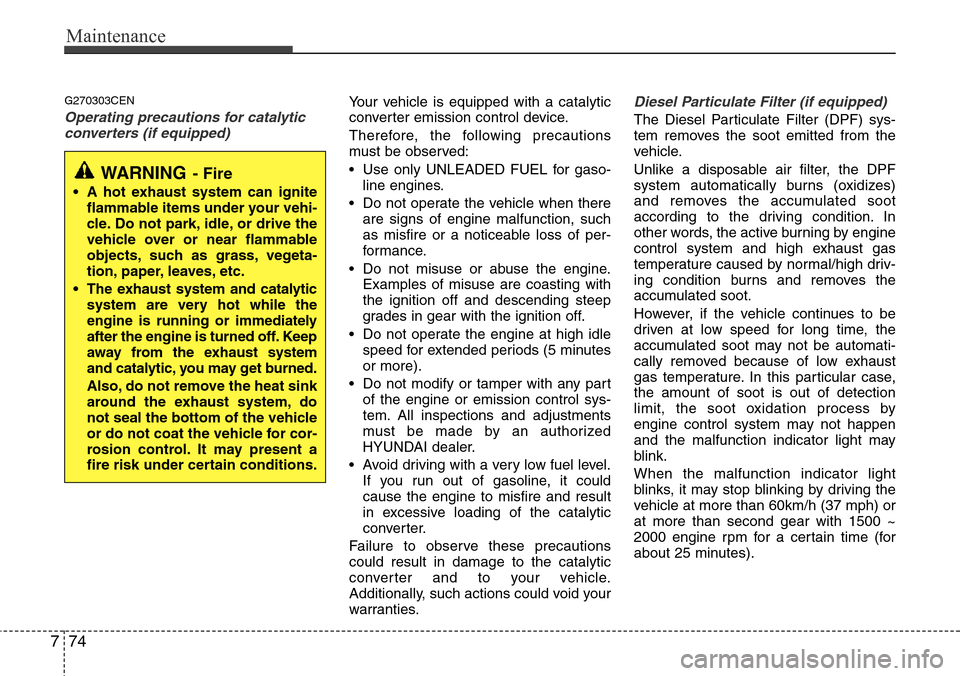
Maintenance
74 7
G270303CEN
Operating precautions for catalytic
converters (if equipped)Your vehicle is equipped with a catalytic
converter emission control device.
Therefore, the following precautions
must be observed:
• Use only UNLEADED FUEL for gaso-
line engines.
• Do not operate the vehicle when there
are signs of engine malfunction, such
as misfire or a noticeable loss of per-
formance.
• Do not misuse or abuse the engine.
Examples of misuse are coasting with
the ignition off and descending steep
grades in gear with the ignition off.
• Do not operate the engine at high idle
speed for extended periods (5 minutes
or more).
• Do not modify or tamper with any part
of the engine or emission control sys-
tem. All inspections and adjustments
must be made by an authorized
HYUNDAI dealer.
• Avoid driving with a very low fuel level.
If you run out of gasoline, it could
cause the engine to misfire and result
in excessive loading of the catalytic
converter.
Failure to observe these precautions
could result in damage to the catalytic
converter and to your vehicle.
Additionally, such actions could void your
warranties.Diesel Particulate Filter (if equipped)
The Diesel Particulate Filter (DPF) sys-
tem removes the soot emitted from the
vehicle.
Unlike a disposable air filter, the DPF
system automatically burns (oxidizes)
and removes the accumulated soot
according to the driving condition. In
other words, the active burning by engine
control system and high exhaust gas
temperature caused by normal/high driv-
ing condition burns and removes the
accumulated soot.
However, if the vehicle continues to be
driven at low speed for long time, the
accumulated soot may not be automati-
cally removed because of low exhaust
gas temperature. In this particular case,
the amount of soot is out of detection
limit, the soot oxidation process by
engine control system may not happen
and the malfunction indicator light may
blink.
When the malfunction indicator light
blinks, it may stop blinking by driving the
vehicle at more than 60km/h (37 mph) or
at more than second gear with 1500 ~
2000 engine rpm for a certain time (for
about 25 minutes).
WARNING- Fire
• A hot exhaust system can ignite
flammable items under your vehi-
cle. Do not park, idle, or drive the
vehicle over or near flammable
objects, such as grass, vegeta-
tion, paper, leaves, etc.
• The exhaust system and catalytic
system are very hot while the
engine is running or immediately
after the engine is turned off. Keep
away from the exhaust system
and catalytic, you may get burned.
Also, do not remove the heat sink
around the exhaust system, do
not seal the bottom of the vehicle
or do not coat the vehicle for cor-
rosion control. It may present a
fire risk under certain conditions.
Page 330 of 338
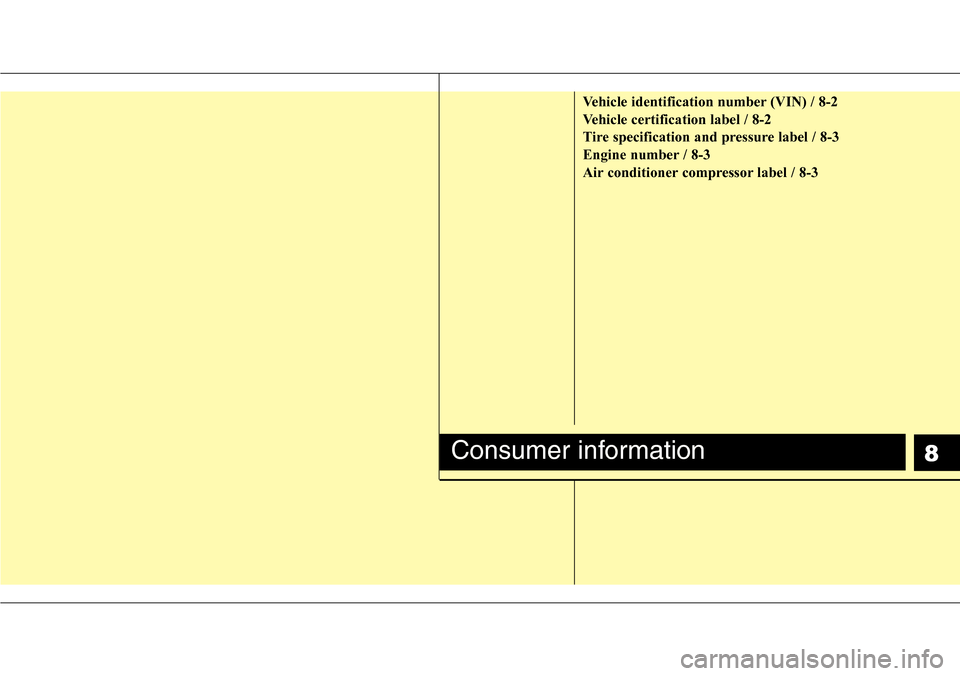
8
Vehicle identification number (VIN) / 8-2
Vehicle certification label / 8-2
Tire specification and pressure label / 8-3
Engine number / 8-3
Air conditioner compressor label / 8-3
Consumer information
Page 332 of 338
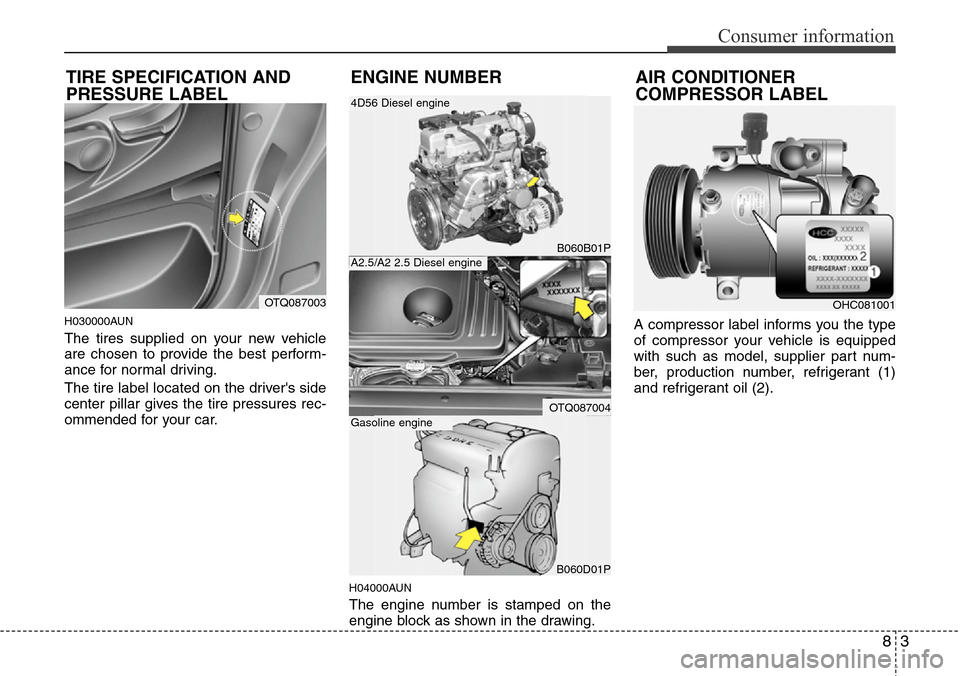
83
Consumer information
H030000AUN
The tires supplied on your new vehicle
are chosen to provide the best perform-
ance for normal driving.
The tire label located on the driver's side
center pillar gives the tire pressures rec-
ommended for your car.
H04000AUN
The engine number is stamped on the
engine block as shown in the drawing.A compressor label informs you the type
of compressor your vehicle is equipped
with such as model, supplier part num-
ber, production number, refrigerant (1)
and refrigerant oil (2).
OTQ087003
B060B01P
OTQ087004
B060D01P
4D56 Diesel engine
A2.5/A2 2.5 Diesel engine
Gasoline engine
TIRE SPECIFICATION AND
PRESSURE LABELENGINE NUMBER
OHC081001
AIR CONDITIONER
COMPRESSOR LABEL
Page 336 of 338
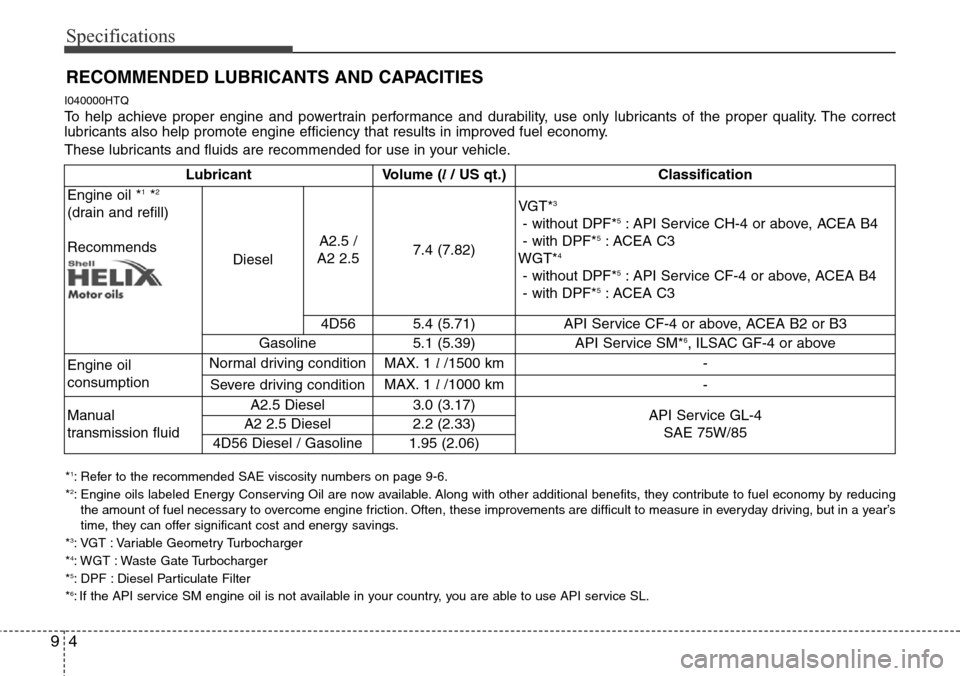
Specifications
4 9
RECOMMENDED LUBRICANTS AND CAPACITIES
I040000HTQ
To help achieve proper engine and powertrain performance and durability, use only lubricants of the proper quality. The correct
lubricants also help promote engine efficiency that results in improved fuel economy.
These lubricants and fluids are recommended for use in your vehicle.
*1: Refer to the recommended SAE viscosity numbers on page 9-6.
*2: Engine oils labeled Energy Conserving Oil are now available. Along with other additional benefits, they contribute to fuel economy by reducing
the amount of fuel necessary to overcome engine friction. Often, these improvements are difficult to measure in everyday driving, but in a year’s
time, they can offer significant cost and energy savings.
*
3: VGT : Variable Geometry Turbocharger
*4: WGT : Waste Gate Turbocharger
*5: DPF : Diesel Particulate Filter
*6: If the API service SM engine oil is not available in your country, you are able to use API service SL.
LubricantVolume (l/ US qt.)
Classification
Engine oil *1*2
(drain and refill)
Recommends
DieselA2.5 /
A2 2.57.4 (7.82)VGT*3
- without DPF*5: API Service CH-4 or above, ACEA B4
- with DPF*5: ACEA C3
WGT*4
- without DPF*5: API Service CF-4 or above, ACEA B4
- with DPF*5: ACEA C3
4D56 5.4 (5.71) API Service CF-4 or above, ACEA B2 or B3
Gasoline 5.1 (5.39) API Service SM*
6, ILSAC GF-4 or above
Engine oil
consumptionNormal driving conditionMAX. 1 l/1500 km
-
Severe driving conditionMAX. 1 l/1000 km
-
Manual
transmission fluid A2.5 Diesel 3.0 (3.17)
API Service GL-4
SAE 75W/85
A2 2.5 Diesel2.2 (2.33)
4D56 Diesel / Gasoline 1.95 (2.06)
Page 337 of 338
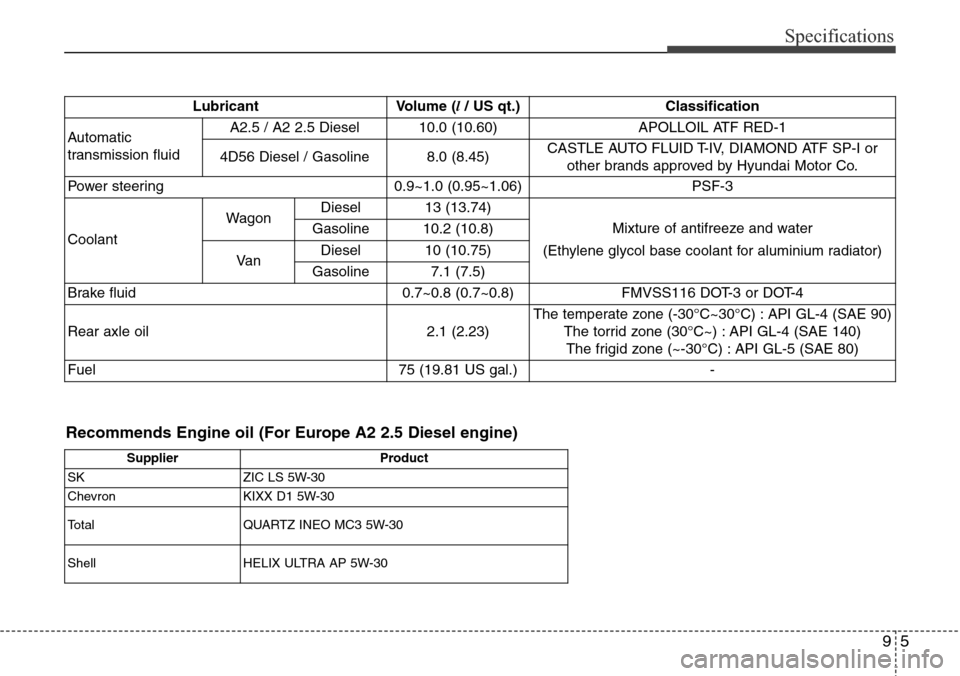
95
Specifications
LubricantVolume (l/ US qt.)
Classification
Automatic
transmission fluidA2.5 / A2 2.5 Diesel10.0 (10.60)APOLLOIL ATF RED-1
4D56 Diesel / Gasoline8.0 (8.45)CASTLE AUTO FLUID T-IV, DIAMOND ATF SP-I or
other brands approved by Hyundai Motor Co.
Power steering 0.9~1.0 (0.95~1.06) PSF-3
CoolantWagonDiesel 13 (13.74)
Mixture of antifreeze and water
(Ethylene glycol base coolant for aluminium radiator) Gasoline 10.2 (10.8)
Va nDiesel 10 (10.75)
Gasoline 7.1 (7.5)
Brake fluid 0.7~0.8 (0.7~0.8) FMVSS116 DOT-3 or DOT-4
Rear axle oil 2.1 (2.23)The temperate zone (-30°C~30°C) : API GL-4 (SAE 90)
The torrid zone (30°C~) : API GL-4 (SAE 140)
The frigid zone (~-30°C) : API GL-5 (SAE 80)
Fuel 75 (19.81 US gal.) -
Recommends Engine oil (For Europe A2 2.5 Diesel engine)
Supplier Product
SK ZIC LS 5W-30
Chevron KIXX D1 5W-30
Total QUARTZ INEO MC3 5W-30
Shell HELIX ULTRA AP 5W-30
Page 338 of 338
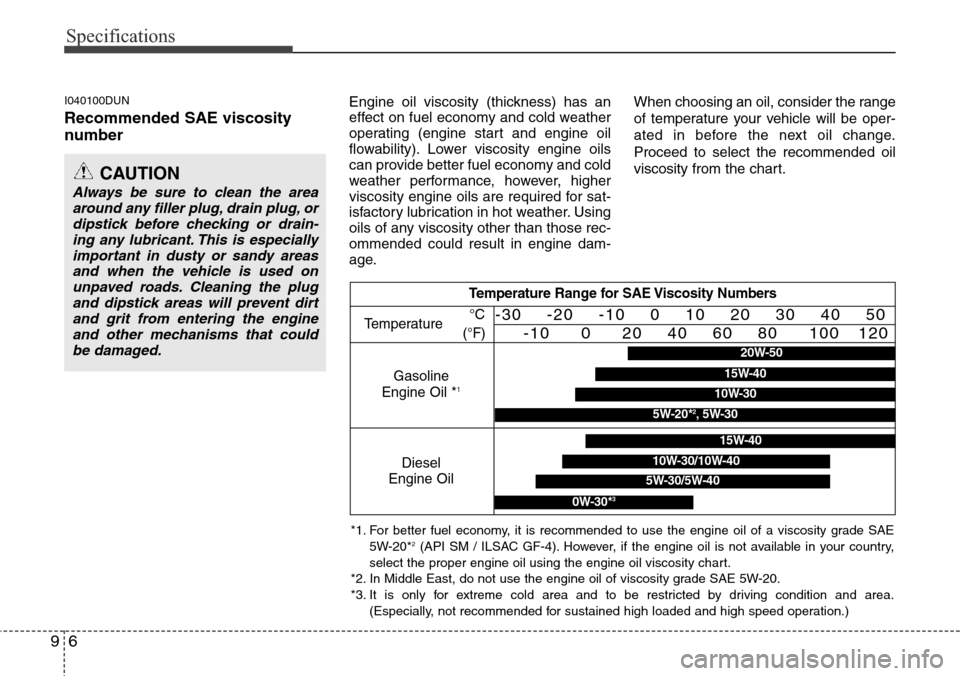
Specifications
6 9
I040100DUN
Recommended SAE viscosity
number
Engine oil viscosity (thickness) has an
effect on fuel economy and cold weather
operating (engine start and engine oil
flowability). Lower viscosity engine oils
can provide better fuel economy and cold
weather performance, however, higher
viscosity engine oils are required for sat-
isfactory lubrication in hot weather. Using
oils of any viscosity other than those rec-
ommended could result in engine dam-
age.When choosing an oil, consider the range
of temperature your vehicle will be oper-
ated in before the next oil change.
Proceed to select the recommended oil
viscosity from the chart.
CAUTION
Always be sure to clean the area
around any filler plug, drain plug, or
dipstick before checking or drain-
ing any lubricant. This is especially
important in dusty or sandy areas
and when the vehicle is used on
unpaved roads. Cleaning the plug
and dipstick areas will prevent dirt
and grit from entering the engine
and other mechanisms that could
be damaged.
Temperature Range for SAE Viscosity Numbers
Temperature
Gasoline
Engine Oil *
1
°C
(°F)-30 -20 -10 0 10 20 30 40 50
-10 0 20 40 60 80 100 120
Diesel
Engine Oil
5W-30/5W-40
15W-40
10W-30/10W-40
0W-30*3
*1. For better fuel economy, it is recommended to use the engine oil of a viscosity grade SAE
5W-20*2(API SM / ILSAC GF-4). However, if the engine oil is not available in your country,
select the proper engine oil using the engine oil viscosity chart.
*2. In Middle East, do not use the engine oil of viscosity grade SAE 5W-20.
*3. It is only for extreme cold area and to be restricted by driving condition and area.
(Especially, not recommended for sustained high loaded and high speed operation.)
20W-50
10W-30
15W-40
5W-20*2, 5W-30